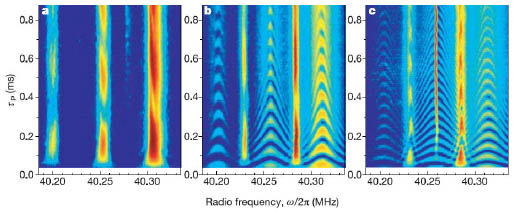Go Yusa*, Koji Muraki, Kei Takashina, Katsushi Hashimoto† and Yoshiro Hirayama
Physical Science Laboratory
The analytical technique of nuclear magnetic resonance (NMR) is based on coherent quantum mechanical superposition of nuclear spin states. Recently, NMR has received considerable renewed interest in the context of quantum computation and information processing, which require controlled coherent qubit operations. However, standard NMR is not suitable for the implementation of realistic scalable devices, which would require all-electrical control and the means to detect microscopic quantities of coherent nuclear spins. Here we present a self-contained NMR semiconductor device that can control nuclear spins in a nanometer-scale region.
We has verified that strong interactions between electron and nuclear
spins are produced under certain conditions where two-dimensional electrons
enclosed in GaAs quantum well has a degenerate state between spin polarized
and unpolarized n=2/3 states. This phenomenon has been successfully applied to precision
control of nuclear spins in a nanoscale semiconductor device. The compactly
integrated structure has opened the way for nuclear spin control with unprecedented
precision. The quantum-mechanical superposition between four separated
states peculiar to the nuclei of gallium (Ga) and arsenic (As) can be fully
controlled in our device.
The successful control of nuclear spin with a nanoscale device, which is notably an all-electrical control, is a significant step forward towards scalable nuclear spin quantum computers. Our approach also enables the direct detection of (otherwise invisible) multiple quantum coherences between levels separated by more than one quantum of spin angular momentum. This microscopic high sensitivity NMR technique is thus especially suitable for probing materials whose nuclei contain multiple spin levels, and may attractive as a nanoscale NMR technology using an extremely small volume of material.
[1] G. Yusa, K. Muraki, K. Takashina, K. Hashimoto, and Y. Hirayama, Nature
434 (2005) 1001.
Present address: *Tohoku University, †Hamburg University
 |
||
|